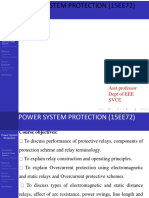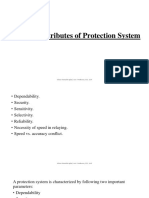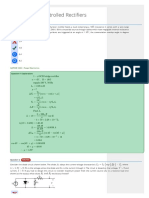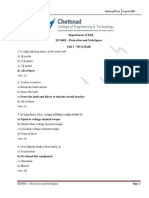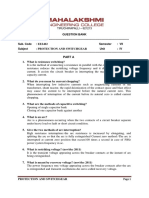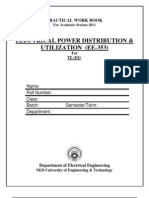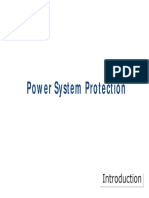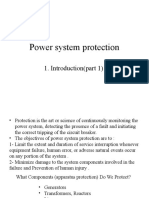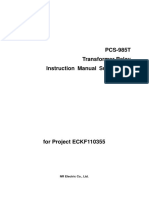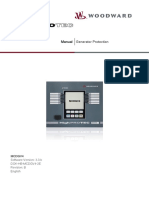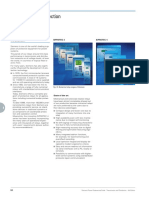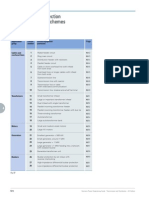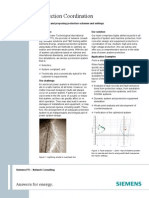PRINCIPLES
OF POWER SYSTEM
PROTECTION
Part 1
Bob Coulter
1
Principles
Power System
Protection
PowerofSystem
Protection
�Purpose of Protection Engineering
Protection engineering is the branch of electrical power
engineering concerned with the design and operation of
protection schemes
The purpose of protection is to minimise the effects of faults
on electrical power systems - note faults can never be
entirely avoided
Protection schemes are specialised control systems that
monitor the power system - detect faults or abnormal
conditions and then initiate corrective action
In this context the power system is considered all the plant
and equipment necessary to generate, transmit, distribute
and utilise electrical power
Principles of Power System Protection
�The Electrical Power System
GENERATION
TRANSMISSION
500kV, 330kV
275kV, 200kV,
132kV
SUBTRANSMISSION
132kV, 110kV,
66kV, 33kV, 22kV
Terminal Station or
Transmission Substation
Power Station
Embedded
Generation
Zone
Substation
Standby Generation
Embedded
Generation
Distribution
Embedded
Generation
Substation
CUSTOMER
LOAD
415/240V, 480/240V
CUSTOMER
INSTALLATION
SECONDARY
or LV DISTRIBUTION
33kV, 22kV, 11kV, 6.6kV, SWER
PRIMARY or HV DISTRIBUTION
3
Principles of Power System Protection
�Power System Secondary Systems include
Protection
Auto control for voltage, frequency, reactive power compensation,
power flow, network configuration and stability
Metering for billing, operational control and statistical data
Local manual control (plant status, voltage level reactive power
support, network configuration)
Remote manual control via communications links (SCADA)
Plant condition monitoring and alarming (temperature,
malfunction, maintenance need, operating duty)
Communications infrastructure
Instrument transformers current and voltage transformers
4
Principles of Power System Protection
�Types of Fault and Abnormality
Short-circuit faults (3, 2, g, 2g)
Open-circuit faults (open conductor)
Complex faults (inter-circuit, broken conductor, cross-country etc)
Inter-turn faults in windings
Abnormalities:
Overload and excessive operating temperature
Real power deficit - underfrequency
Power swings
Power frequency overvoltage or undervoltage
Underexcitation of synchronous machines
Overfluxing of power transformers
Asynchronous operation of synchronous machines
Overfrequency
Mechanical defects ie. leaking oil, tapchanger mechanism faults etc
5
Principles of Power System Protection
�Causes of Short
-Circuit Faults
Short-Circuit
Insulation breakdown due to inherent weakness
Lightning
Birds and animals bridging insulators
Dig-ups for underground cables
Poles collapsing
Conductors breaking
Willful damage
Vehicle impact
Wind borne debris
Incorrect operation by personnel
etc
6
Principles of Power System Protection
�Effects of Short
-Circuit Type Faults
Short-Circuit
Large or very large currents can flow through parts of the network
thousands or tens of thousands of Amps can be involved
These large currents can only be allowed to flow for a very short
time otherwise equipment and generators would be damaged,
most likely terminally allowable short-circuit current flow
duration could range from as short as 10 milliseconds up to say 3
seconds.
Arcs, sparking and the heating effect of short-circuit currents can
start fires involving non-electrical assets/property
Very large mechanical forces can be caused by short-circuit
currents which have potential to break or damage equipment
Electric current can escape from the network conductors and
flow through paths where they could create a hazard to people or
livestock and cause damage to non-electrical assets/property
Principles of Power System Protection
�Large Transformer Fire
8
Principles of Power System Protection
�Short
-circuit Type Faults
Short-circuit
R
3 Fault
2 Fault
-e Fault
2-e Fault
Principles of Power System Protection
�Short
-circuit Type Faults with Fault Impedance
Short-circuit
R
Zf1
Zf2
Zf3
Zf
3 Fault
2 Fault
B
Zf1
Zf2
Zf
Zf3
10
-e Fault
2-e Fault
Principles of Power System Protection
�Some Causes of Fault Impedance
Arc resistance
Pole, tower or structure footing resistance to earth
Resistance things that may come in contact with a
line i.e. tree, crane etc
Contact resistance where a conductor falls to the
ground
For protection design it is important to recognise that
fault impedance can significantly reduce the
magnitude of fault currents and take this into account
11
Principles of Power System Protection
�Series Type Faults
R
1 Open
12
2 Open
Zf1
Zf2
Zf
Series impedance in 1
Series impedance in 2s
Principles of Power System Protection
�Some Complex Fault Types
R
R
W
B
Circuit 1
R
W
B
Zf
R
W
B
Zf
Broken conductor fault
Inter-circuit fault
R
W
B
-e Fault at
Location 1
13
Circuit 2
R
W
B
Cross country fault
-e Fault at
Location 2
R
W
B
Principles of Power System Protection
�Faults in Windings
Short-circuited
turns
Fault
If
14
Principles of Power System Protection
�Protection Function - Components
Bus
CB
PR
Protection Relay
CB
Circuit Breaker
Equip
Protected Item
CT
Current Transformer
VT
Voltage Transformer
DC Aux
DC Auxiliary supply
HMI
Man-machine interface
PCL
Communications Link
Tr
CB trip coil
Equip
CT
Tr
PR
VT
DC Aux
HMI
P
C
L
Control
Basic Arrangement of a
Protection Scheme
15
Principles of Power System Protection
�Protection Schemes Key Factors
Automatic and correct diagnosis of faults and abnormalities
Quick response measured in milliseconds to a few
seconds at the most
Must operate reliably
Can be viewed as a form of active insurance intended to
maintain high degree of service continuity and limit losses
through equipment and plant damage
16
Principles of Power System Protection
�Basic Objectives of a Network Protection System
Detect faults and unacceptable abnormalities and
isolate faulty section of network as quickly as
possible
Minimise extent of damage at fault point
Minimise effect fault has on rest of power system
Minimise danger to life and property
Minimise extent and duration of outage
17
Principles of Power System Protection
�Protection Application Concepts
Substation A
PR
PR
Substation B
PR
PR
Source
Network
PR
PR
Short-circuit fault
on Line B-C
Substation D
Substation C
18
Fault current flow
Circuit Breaker
Circuit breaker to be opened
Principles of Power System Protection
�Protection Application Concepts - continued
19
Protection relays are associated with each network plant
equipment item or circuit (ie line, cable, transformer, generator,
busbar etc)
Protection relays closest to the fault location should operate first
Circuit breakers closest to fault should be opened first
Fault current components will flow in other (unfaulted) circuits
protection relays associated with these should not operate in the
first instance
As protection relays or circuit breakers may fail to operate during
a fault on occasions, back-up is necessary
Concepts of protection function
Security
Availability, Reliability and
Principles of Power System Protection
�Protection Application Concepts - continued
Protection
Relay for
Busbar
PR
Unprotected
Zone
PR
Protection
Relay for
Circuit
Protection
Relay for
Busbar
PR
PR
Circuit
Circuit
Busbar
Busbar
Fault
No overlap of current transformers
Protection
Relay for
Busbar
PR
Fault
20
PR
Protection
Relay for
Circuit
Protection
Relay for
Circuit
Fault
Overlapped current transformers
correct practice
Protection
Relay for
Busbar
PR
PR
Protection
Relay for
Circuit
Circuit
Fault between current transformers
and circuit breaker
Current transformers on both
sides of circuit breaker
Principles of Power System Protection
�Impacts of Protection Scheme Performance on
Power System Performance
Reliability of supply
Quality of supply voltage dip severity
Danger to public and livestock step and touch potentials
Hazards to other utilities assets gas, water and
telecommunications
Fire ignition bushfires, equipment fires and customer
installation fires
Operator safety
Network damage and repair cost
21
Principles of Power System Protection
�Performance Requirements of Protection
Systems - 1
Discriminate between load (normal) and fault (abnormal)
conditions
Not be confused by non-damaging transient conditions
Be selective coordinate with other protection systems
Fast enough to prevent damage and hazards but not too
fast
Have no blind spots i.e. unprotected zones
Be able to handle maximum fault current duty
22
Principles of Power System Protection
�Performance Requirements of Protection
Systems - 2
High degree of reliability and availability
Secure against incorrect operation (security)
An acceptable compromise between reliability and security
is required reliability should take precedence
Should not restrict rating of primary plant and equipment
Should be affordable
23
Principles of Power System Protection
�Methods of Detecting Faults
Magnitude of current Overcurrent protection
Magnitude of current in earth or neutral Earth Fault protection
Magnitude and Phase Angle of current Directional Overcurrent protection
Magnitude and Phase Angle of current in earth or neutral Directional Earth Fault
protection
Magnitude and Angle of Impedance (Ratio V/I) Impedance protection
Difference between two or more currents Differential protection
Difference between Phase Angles of two currents Phase Comparison protection
Magnitude of negative sequence current
Magnitude of Voltage Overvoltage or Undervoltage protection
Magnitude of Frequency Over or Underfrequency protection
Temperature Thermal protection
Specials i.e. transformer gas protection,
24
Principles of Power System Protection
�Types of Protection Relay
Electromechanical
Electronic analogue using discrete components
Electronic analogue using ICs
Microprocessor
Microprocessor + DSP (Digital Signal Processor)
25
Principles of Power System Protection
�Digital Protection Relays
Input measured quantities conditioned, filtered and digitised
All protection functions done via software in
microprocessor(s) or DSP(s)
Communications processors for HMI, control interfacing
and data transfer
Digital I/O for protection communications aspects
Software driven HMI
Relays for circuit breaker tripping
26
Principles of Power System Protection
�Enhanced Performance Provided by Digital
Relays
Better accuracy of protection function measurements i.e.
less margin required for measuring errors (time, current,
voltage, impedance, phase angle)
True RMS sensing and unaffected by transient components
of fault voltage and current signals
Tuning or rejection of non-power frequency currents in
sensitive earth fault protection
Complete catalogue of timing functions
Result better protection coverage, shorter operating times,
better load carrying capability and enhanced security
27
Principles of Power System Protection
�New Functions
Protection functions done in software
Once input voltages and currents are digitised, new and
additional functionality can be added at low cost
For example:
28
Negative sequence protection for distribution feeders
Impedance measurement instead of current
Circuit breaker fail logic
Thermal modelling
Circuit breaker duty
Directional features
Other input signals can be added
Can use improved fault detection techniques
for much lower cost
Principles of Power System Protection
�Communication Links
Needed to exploit power of digital protection
For relay to relay protection functionality such as blocking,
acceleration schemes digital I/O
For protection operation principle such as line differential
For interfacing into substation digital control schemes
For operation command use such as resetting,
suppression/restoration, setting group selection
For data retrieval event logs, metered quantity logs,
oscillographic records
For maintenance, i.e. downloading new
software or settings remotely
29
Principles of Power System Protection
�Communications Links Used for Protection
Utility owned metallic communications cables (called
supervisory or pilot cables
Optical fibre cables
Power Line Carrier (PLC)
UHF or Microwave radio
Leased links from a Telco
30
Principles of Power System Protection
�Summary
Protection systems are critical elements of the power
system and their and their operating performance
impacts directly on the power systems safety and
reliability
31
Principles of Power System Protection

